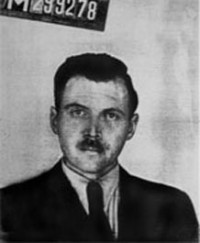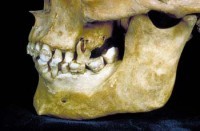Stephen F. Dachi was a consular officer who was born in Hungary in 1933. His parents both died when he was three years old, leaving him in the care of his grandparents, who lived in Romania. After emigrating, he became a dentist, and then later joined the Foreign Service. When serving in Brazil in the mid‐1980s, he helped with the forensic identification of Josef Mengele, "the Angel of Death" infamous for his experiments on prisoners in Auschwitz, including young children.
Read the entire account on ADST.org
DACHI: Josef Mengele was a doctor with the German SS. At Auschwitz, he was the man who conducted the bulk of the medical experiments on the inmates and, in particular, was doing all this research on twins that became so notorious subsequently. He was one of the major Nazi war criminals who was not in custody at the time of the Nuremberg trials. After the war, he hid in Germany for a while but then with the assistance of his family, which owned a farm tool company, escaped to Argentina, where he lived under an alias for quite a few years during the Peron era without much danger to him. After Peron was deposed in 1955, many of the Nazi war criminals hiding in Argentina began to feel less safe and Mengele for one, moved to Paraguay. He acquired Paraguayan citizenship under his own name. President Alfredo Stroessner the Paraguayan dictator was well‐known for hiding Nazi war criminals, although Argentina was the most notorious of them all.
In 1961, after about 18 months in Paraguay, Mengele moved to Brazil. By that time, the West German government was trying to look into his possible extradition. Another dangerous development for him was the fact that the chief administrator of the Holocaust, Adolf Eichmann, had been captured in Argentina in 1960 by the Mossad, the Israeli intelligence service, and spirited out to Israel, where he was tried, convicted, and eventually executed.
Mengele went to Brazil in 1961 and went back undercover with a new alias, Peter Hochbichler. He was taken to a remote farm in the interior of Sao Paulo state by a fellow Nazi who aided him in crossing the border, and he was sheltered there by an Austro‐Hungarian Nazi couple for several years. They at first didn't know who he was. Later they found out but continued to shelter him. He eventually moved on to be harbored by a German‐Brazilian couple with Nazi sympathies in Sao Paulo.
In 1978, he went to the beach in Bertioga, a town not far from Sao Paulo with this German couple. While he was swimming he had a stroke and, as a result, he drowned. They buried him secretly under a false name. Even after all that time everybody in the world still thought that he was in Paraguay. No one suspected he was in Brazil.
All those years, no one, not even in the network of the many Nazi fugitives hiding out in neighboring countries, really knew where he was. His family in West Germany always knew and had been in regular contact with him both by mail and through personal emissaries. But they had always paid off enough people in the local police in Günzburg, Germany where they lived, so that they could never find or seize any evidence.
Then in 1985, about the time I arrived in Brazil, the last guy at the local police in Günzburg that they had paid off died or retired. At that point the German police raided the Mengele family house and for the first time caught them by surprise and found some letters and other documents. Based on that evidence, they found out where he had been living. They came over to Brazil, staked the place out in the Sao Paulo suburb of Santo Amaro, and together with Brazilian police went in, seized the couple that had hidden him, and learned that Mengele was no longer alive. The family took them to a grave where they claimed they had secretly buried him and the remains were exhumed.
Then the large-scale operation to determine if this really was or wasn't Mengele began. The U.S. had just signed an agreement with Germany and Israel that we would henceforth cooperate more closely on Nazi hunting operations. But the Germans were so eager to nail Mengele and get the sole credit for it that they actually came over and, together with the Brazilian police, staked out the house and exhumed his body without telling us. Of course, we didn't like that, to put it mildly.
In any case, the Brazilians didn't buy into the proposition that all this was to be done in secret, and we found out about it when they invited a TV crew to the exhumation, which was then covered in macabre detail on national television. Within hours a large group of people, including hordes of journalists, were on the way down from the United States. The Justice Department sent a team of forensic specialists, including fingerprint and handwriting experts. A group of U.S. Marshals was on the way. The Simon Wiesenthal Center in Los Angeles was sending its own set of independent specialists. This was serious business....My instructions were to follow this case for the U.S. government because, better late than never, we wanted to know exactly what was going on and we wanted to make certain that we knew for sure whether this really was Mengele or not. Nowadays you can identify people by DNA. That was not yet the case back in 1985. You only had fingerprints and dental records. Of course, there were no fingerprints. The exhumation only yielded a skeleton.
If you have dental x‐rays taken of someone before he died and you are certain of his identity, you can take x‐rays of the skull and match up the teeth very accurately. So a bunch of people went to work on this. I was just an observer at that point. After about a week, the various forensic specialists started comparing and discussing their findings.The Germans were the most methodical. They projected a chart of the skull on the wall. On that slide they had over 40 numbers or labels attached to each anatomical angle, curvature, and point on the skull. Through a technique called craniometry you can match that up with photographs of the person you are trying to identify and measure those same features. Then you overlap them and, if they match, you can make a pretty good identification.
Well, they put this thing up on the wall. They had everything on that skull numbered for every single anatomical feature of the skull. There was only one thing on that skull that didn't have a number next to it. That was a hole in the left cheekbone which was clearly not an anatomical feature. It was a hole that, to me at least, was obviously caused by a pathological [disease based] process. With all the experts and scientists who were sitting there looking at it, not one of them had noticed it.
I took a look and said, "What the hell is that hole doing there?"They said, "What hole?"
I said, "See that hole over there? You don't have a number by that one and that's not an anatomical hole."
They said, "Really? What do you know about it?"
I said, "Well, in my younger days I not only was a dentist, but I happen to have specialized in oral pathology and was a diplomate of the American Board of Pathology. Come and take a look at this skull."
We took a closer look at the skull and, sure enough, it became apparent to everyone that this was most likely to be a pathological hole, not an anatomical feature. After several days of discussing and weighing the options they asked me to do the pathology work together with a Brazilian specialist and try to establish that this hole really was a pathological abnormality and not an anatomical feature.
So, together with the Brazilian pathologist, we prepared some slides from the bone tissue and performed a microscopic examination. We established that there had been a long‐term infection in the maxillary sinus of Mengele's upper jaw.
From questioning the people who had harbored him, we knew that while he was hiding out in Brazil he would get big dental abscesses and infections with swelling in his face and that some years later he had had a root canal done. During his first few years in Brazil he had been afraid to go to the dentist because he was afraid of being discovered.
So, since he was a physician, he would lance the abscesses with a razor blade and drain the abscess himself. So basically he had an infected tooth for several years before he had a root canal done, and because this infection was not treated properly for so long, it worked its way into the sinus and eventually leaked or drained out to the face through the perforation or hole in the part of the cheekbone covering the maxillary sinus.
By the way, there was a scar on the face that matched the hole in the skull that they didn't notice either. I said, "Hey, this is where the tract that the infection was draining through chronically over the years broke through the skin."
Once we established by microscopic examination that the hole in the skull was connected to the infected maxillary sinus, the officials in the Office of Special Investigations [of Nazi war criminals] at the Department of Justice had me come up to the Smithsonian to make a presentation of the evidence.
I showed them the results of the study and explained the whole thing. The findings were accepted as valid by all the specialists. Then came the end game. The people from the Department of Justice said to me, "Look, in the meantime, we have studied Mengele's diaries that were found in the house in Santo Amaro.
They have been authenticated by handwriting specialists who have confirmed that they were written in Mengele's hand. In the diary, Mengele made several notations about going to a dentist to have a root canal done. Obviously, there must be some dental x‐rays from that root canal somewhere in Brazil. "Would you be able to find them?"
We all knew that if we could find the dental x‐rays, we could do the standard, legally valid forensic comparison and definitive identification. I agreed to try. When I returned to Sao Paulo, the first thing I did was to go to the Brazilian Federal Police. The diary was written in a crude, informal code, so it wasn't totally clear to any of us who that dentist might be. But I gave the information to the Brazilian police. They came back within two or three weeks and said, "We can't find him."
Then the Justice Department asked me if I would look into it further on my own, since the Brazilian Federal Police wasn't able or willing to do it. I then undertook a detailed investigation. I broke the code of the diary. With that and with various other bits of information eventually I found the two dentists who had treated him, one the specialist who had done the root canal and the other the general practitioner who had made the referral. Then I found the x‐rays in the files of the general dentist. With these x‐rays in hand, the forensic dentist from New York who was a member of the original team returned to Sao Paulo and the final identification was done.
This created an international problem that perhaps would be of interest to talk about here. But just to finish the dental part, there were a number of people who could not accept this evidence, even though medically it was beyond any argument.
Five years or so later, the DNA tests which had come into use by then were done and authenticated the findings. They validated what I had done. At that point, the German government finally accepted the identification. (The Department of Justice had accepted the finding immediately upon completion of my investigation in 1986.)
The government of Israel has not said anything publicly one way or the other to this day. I should add, however, that the chief coroner of the Mossad came over to Sao Paulo in late 1986 and went over my work with a fine tooth comb. Afterwards he came to my office and told me outright that, based on his own review, he was convinced that everything I had done had been absolutely correct and that there was no question in his mind about the validity of the identification...



